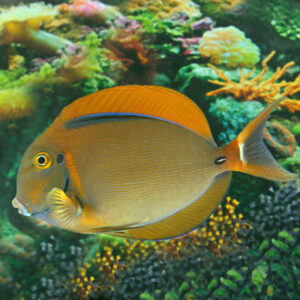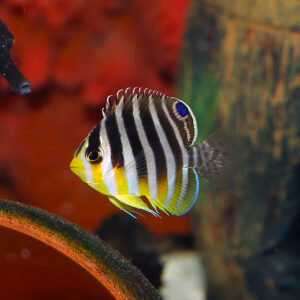Bariene Tangs, Acanthurus bariene, also go by the name Black Spot Surgeonfish. These fish make brilliant additions to a marine aquarium. Over time, they develop their amazing blue and orange colouration.
These Tangs are a type of ray finned fish that belong to the Acanthuridae family. This family also includes Sawtails and Unicornfish. The defining characteristic for the Acanthuridae family, is the presence of scalpels or spines on both sides of the caudal peduncle. These are used for defence and are usually brightly coloured to act as a deterrent. Bariene Tangs have dusky orange peduncles which help highlight their weapons. The spine itself has a deep blue outline.
Bariene Tangs also belong to the subfamily Acanthurinae. Which means these fish have one spine on each side. These spines are set into a groove and erected by curving the tail. In contrast, the other two subfamilies own fixed spines. Unicornfish, or Nasos, have one or more hooked spine, while Sawtails develop a series of spines with age. Sometimes up to seven. Sawtails are made up of the genus Prionurus only and not seen in trade.
Bariene Tangs, Acanthurus bariene, Ecology.
These fish live on coral reefs in the Indo-West Pacific. Their range extends from Africa to the Maldives. As young fish, Bariene Tangs live in sheltered areas, usually amongst soft coral. The complex structure help the fish avoid predation. When threatened they will find refuge in nooks and crannies.
On the reef, Bariene Tangs graze on film algae and hunt zooplankton. Like many Tangs, these fish can be helpful for controlling algae growth. Left unchecked, algae could outcompete slower growing coral species for space and light. Their help can be more pronounced on shallower reefs that capture more sunlight.
Black Spot Surgeonfish In the Aquarium.
It is important to have plenty of nooks or crannies in order to imitate the natural environment. This will help your Bariene Tangs establish its own territory. Aquaroche and Aquaroche shelves can be helpful for this. Hobbyists should also think about using a jump guard to stop any loses.
Bariene Tangs do best when fed a varied diet. Here they are eating a good quality pellet and flake food, such as Jbl Maris. Our Tangs are also offered ocean nutrition seaweed, that can be secured to the side of the tank with clips.
They will happily eat enriched frozen: mysis shrimp and brine shrimp and krill, in the case of the larger fish. We enrich all our frozen food with seachem garlic guard and Atvitol vitamins. These are imperative for keeping fish healthy and increasing longevity. By providing the fish with the nutrition that is otherwise lost in frozen food, these additives support the tangs immune system and helps ward off white spot.
In addition, Tangs will also eat live foods, such as copepods and amphipods, that can be cultivated in attached refugium. Our Tangs are adapted to aquarium life before being offered for sale. So they are eating dry food and/or frozen food when they leave us.
Tangs can be kept alone or in groups. If considering the latter, feel free to give us a call to discuss further. Hobbyists can keep multiple tangs together, although we encourage you seek advice if you are unsure or have questions.





Reviews
There are no reviews yet.